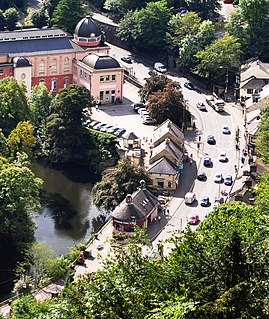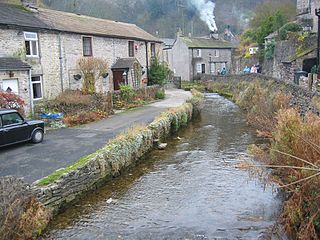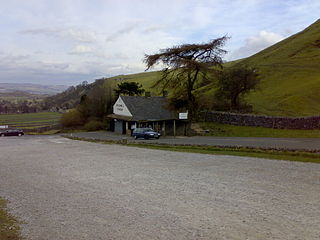
The Peak Cavern, also known as the Devil's Arse, is one of the four show caves in Castleton, Derbyshire, England. Peakshole Water flows through and out of the cave, which has the largest cave entrance in Britain.

The Heights of Abraham is a tourist attraction in Matlock Bath, Derbyshire, England. It consists of a hilltop park on top of Masson Hill, accessed from the village by either the Heights of Abraham cable car or a steep zig-zag path. The heights are named after a supposed resemblance to the Plains of Abraham, also known as the Heights of Abraham, in Quebec, Canada, where James Wolfe died in battle.
Cosmic Cavern is a limestone cave located in north Arkansas, near the town of Berryville, Arkansas. One brochure for the cave touts it as "Arkansas' Most Beautifully Decorated Cave." It is the "warmest" cave in the Ozarks, having a high humidity holding at a constant 64 °F year-round. Most caves in the area are between 55° and 60°.
Mystic Caverns and Crystal Dome are show caves located between the cities of Jasper and Harrison, in the state of Arkansas, U.S., on the Arkansas Highway 7 Scenic Byway near the defunct amusement park Dogpatch USA. Sometimes called "the twin caves" because they are within 400 feet (120 m) of each other, the two caves maintain a year-round temperature of 58 °F, contain more formations per foot than any other caves in Arkansas, and are open for public tours year-round except during the January flooding season.

The Naica Mine of the Mexican state of Chihuahua, is a lead, zinc and silver mine. Located in Naica in the municipality of Saucillo, the Naica Mine is owned by Industrias Peñoles, the world's largest silver producer. Caverns discovered during mining operations contain gigantic crystals of CaSO
4 · 2 H
2O (calcium sulfate dihydrate, gypsum, also sometimes called selenite. Peñoles announced in October 2015 that it was indefinitely suspending operations due to uncontrollable flooding at the Naica Mine.

Craighead Caverns is an extensive cave system located in between Sweetwater and Madisonville, Tennessee. It is best known for containing the United States' largest and the world's second largest non-subglacial underground lake, The Lost Sea. In addition to the lake, the caverns contain an abundance of crystal clusters called anthodites, stalactites, stalagmites, and a waterfall.

California Cavern is a Limestone cave in the Sierra Nevada foothills, in Cave City, Calaveras County, California.

Thor's Cave is a natural cavern located at SK09865496 in the Manifold Valley of the White Peak in Staffordshire, England. It is classified as a karst cave. Located in a steep limestone crag, the cave entrance, a symmetrical arch 7.5 metres wide and 10 metres high, is prominently visible from the valley bottom, around 80 metres (260 feet) below. Reached by an easy stepped path from the Manifold Way, the cave is a popular tourist spot, with views over the Manifold Valley. The second entrance is known as the "West Window", below which is a second cave, Thor's Fissure Cavern.

Peakshole Water is a stream in the Derbyshire Peak District named after its source, Peak Cavern. It flows through the village of Castleton to join the River Noe in nearby Hope. Despite its name, much of its flow actually emerges from the Russet Well, a resurgence in a garden on the east side of the gorge below the main Peak Cavern entrance, described as the "main resurgence of the Castleton area", which drains a series of swallets on the other side of the Pennine watershed below Rushup Edge. The resurgence has been explored by cave divers to a depth of 82 feet (25 m) but further exploration was halted by a constriction.

Llechwedd is a visitor attraction near Blaenau Ffestiniog, Gwynedd, Wales. It details the history of slate quarrying in the town and specifically the Llechwedd quarry in which it is located. The main aspect of Llechwedd is its Llechwedd Deep Mine Tour which has the steepest narrow gauge railway in the UK and travels over 500 feet underground to the disused slate caverns, and the Quarry Explorer Tour which heads out to the furthest reaches of the Llechwedd site to explore the history of mining in the area.

DeSoto Caverns is a series of caves and a tourist attraction located in Childersburg, Talladega County, Alabama. Located in the foothills of the Appalachian Mountains, it is touted as "Alabama's Big Cave". In addition to the caves, the park offers various other attractions, including a three-quarter acre maze known as the Lost Trail Maze, panning for gemstones, a climbing wall, and amusement park style rides. While on the caverns tour, visitors can view a sound, light, and water show that changes with the holidays and seasons.

Moaning Caverns is a solutional cave located in the Calaveras County, California, near Vallecito, California in the heart of the state's Gold Country. It is developed in marble of the Calaveras Formation. It was discovered in modern times by gold miners in 1851, but it has long been known as an interesting geological feature by prehistoric peoples. It gets its name from the moaning sound that echoed out of the cave luring people to the entrance, however expansion of the opening to allow access for the public disrupted the sounds. The portion of the cave developed for tourists consists of a spacious vertical shaft 165 feet tall, which is descended by a combination of stairs and a unique 100-foot-high (30 m) spiral staircase built in the early 1900s. It is open to the public for walking tours and spelunking. Including the off-trail areas, the cave reaches a depth of 410 feet.

Poole's Cavern or Poole's Hole is a two-million-year-old natural limestone cave on the edge of Buxton in the Peak District, in the county of Derbyshire, England.

Titan is a natural cavern near Castleton in the Derbyshire Peak District, and is the deepest shaft of any known cave in Britain, at 141.5 metres (464 ft). The existence of Titan was revealed in November 2006, following its discovery on 1 January 1999 after cavers discovered connections from the James Hall Over Engine Mine to both Speedwell Cavern and Peak Cavern. Previously, the deepest known underground shaft in Britain had been Gaping Gill on the slopes of Ingleborough in the Yorkshire Dales.

Odin Mine is a disused lead mine in the Peak District National Park, situated at grid reference SK133835. It lies on a site of 25 hectares near the village of Castleton, England. It is the oldest documented mine in Derbyshire and is thought to be one of the oldest lead mines in England. The mine is a Scheduled Ancient Monument and has biological and geological significance within the Castleton Site of Special Scientific Interest.

Onondaga Cave State Park is a Missouri state park located on the Meramec River approximately 5 miles (8.0 km) southeast of the village of Leasburg. The park was established in 1982. Park activities include cave tours, camping, fishing, hiking, picnicking, and swimming.
Great Rutland Cavern is one of two caves at the Heights of Abraham, Matlock, Derbyshire, England. The other is Great Masson Cavern.

Crank Caverns is the common name of the remains of the Rainford Delph Quarry near Crank in St. Helens, Merseyside, England. It is a network of tunnels and caverns, as well as an extensive woodland. Information in the St. Helens local history archives states that sandstone quarrying began here as early as 1730. As the quarry expanded, the cost of purchasing land to open cast mine it increased, so it was decided to opt for a different method. Instead of quarrying out the stone, they would mine it out, following a seam of stone until it ran out. This resulted in the network of caves, tunnels and shafts we see today. Rainford Delph is listed as a Colliery by 1854, under the ownership of Charles Howarth or Yorkshire Charlie as he was known locally by 1880. Mining finally ceased and the woods and caverns were used as a game reserve by the Earl of Derby until 1939, when they became a storage facility for ammunition for the anti-aircraft position at Crank. After the war, the caverns ceased use as a game reserve. Today, Crank Caverns are not officially open to the publicand due to their increasing instability, attempts have been made to close access to the caverns and tunnels themselves. Despite this, the site is still physically accessible from a nearby public footpath and is still a draw for generations of curious locals who wish to explore, many having heard the numerous local myths and legends from an early age.
Shute Shelve Cavern is a natural cave system located in Shute Shelve Hill, Somerset, England, above Axbridge in the Mendip Hills not far from Cheddar.















